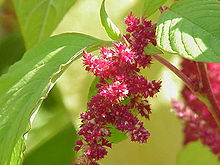Amaranth
| Amaranthus | |
|---|---|
 |
|
| A. tricolor | |
| Scientific classification | |
| Kingdom: | Plantae |
| (unranked): | Angiosperms |
| (unranked): | Eudicots |
| (unranked): | Core eudicots |
| Order: | Caryophyllales |
| Family: | Amaranthaceae |
| Subfamily: | Amaranthoideae |
| Genus: |
Amaranthus L. |
| Species | |
|
See text |
|
| Nutritional value per 100 g (3.5 oz) | |
|---|---|
| Energy | 1,554 kJ (371 kcal) |
|
65.25 g
|
|
| Starch | 57.27 g |
| Sugars | 1.69 g |
| Dietary fiber | 6.7 g |
|
7.02 g
|
|
| Saturated | 1.459 g |
| Monounsaturated | 1.685 g |
| Polyunsaturated | 2.778 g |
|
13.56 g
|
|
| Tryptophan | 0.181 g |
| Threonine | 0.558 g |
| Isoleucine | 0.582 g |
| Leucine | 0.879 g |
| Lysine | 0.747 g |
| Methionine | 0.226 g |
| Cystine | 0.191 g |
| Phenylalanine | 0.542 g |
| Tyrosine | 0.329 g |
| Valine | 0.679 g |
| Arginine | 1.060 g |
| Histidine | 0.389 g |
| Alanine | 0.799 g |
| Aspartic acid | 1.261 g |
| Glutamic acid | 2.259 g |
| Glycine | 1.636 g |
| Proline | 0.698 g |
| Serine | 1.148 g |
| Vitamins | |
| Thiamine (B1) |
(10%)
0.116 mg |
| Riboflavin (B2) |
(17%)
0.2 mg |
| Niacin (B3) |
(6%)
0.923 mg |
| Pantothenic acid (B5) |
(29%)
1.457 mg |
| Vitamin B6 |
(45%)
0.591 mg |
| Folate (B9) |
(21%)
82 μg |
| Vitamin C |
(5%)
4.2 mg |
| Vitamin E |
(8%)
1.19 mg |
| Minerals | |
| Calcium |
(16%)
159 mg |
| Iron |
(59%)
7.61 mg |
| Magnesium |
(70%)
248 mg |
| Manganese |
(159%)
3.333 mg |
| Phosphorus |
(80%)
557 mg |
| Potassium |
(11%)
508 mg |
| Sodium |
(0%)
4 mg |
| Zinc |
(30%)
2.87 mg |
| Other constituents | |
| water | 11.13 g |
|
|
|
|
|
| Percentages are roughly approximated using US recommendations for adults. Source: USDA Nutrient Database |
|
See text
Amaranthus, collectively known as amaranth, is a cosmopolitan genus of annual or short-lived perennial plants. Some amaranth species are cultivated as leaf vegetables, pseudocereals, and ornamental plants. Most of the Amaranthus species are summer annual weeds and are commonly referred to as pigweed.Catkin-like cymes of densely packed flowers grow in summer or autumn. Approximately 60 species are recognized, with inflorescences and foliage ranging from purple, through red and green to gold. Members of this genus share many characteristics and uses with members of the closely related genus Celosia.
"Amaranth" derives from Greek ἀμάραντος (amárantos), "unfading", with the Greek word for "flower", ἄνθος (ánthos), factoring into the word's development as amaranth. The more accurate amarant is an archaic variant.
Amaranthus shows a wide variety of morphological diversity among and even within certain species. Although the family (Amaranthaceae) is distinctive, the genus has few distinguishing characters among the 70 species included. This complicates taxonomy and Amaranthus has generally been considered among systematists as a "difficult" genus.
Formerly, Sauer (1955) classified the genus into two subgenera, differentiating only between monoecious and dioecious species: Acnida (L.) Aellen ex K.R. Robertson and Amaranthus. Although this classification was widely accepted, further infrageneric classification was (and still is) needed to differentiate this widely diverse group.
...
Wikipedia
